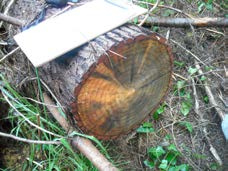PESTS AND DISEASES OF FORESTRY IN NEW ZEALAND
Can we use fire weather data to predict the rate of sapstain development after storms?
Scion is the leading provider of forest-related knowledge in New Zealand
Formerly known as the Forest Research Institute, Scion has been a leader in research relating to forest health for over 50 years. The Rotorua-based Crown Research Institute continues to provide science that will protect all forests from damage caused by insect pests, pathogens and weeds. The information presented below arises from these research activities.
From Forest Health News 245, February 2014.
The appearance of sapstain with its associated monetary loss is always a worry to forest managers who have to recover valuable wood from plantations damaged by storms. One of the uncertainties is in knowing just how much time is available before the broken stems deteriorate to the point when a salvage operation is no longer economic. Because sapstain fungi and the risk from fire are both influenced by the rate at which the wood dries, it was suggested that publically available fire weather data might be used to predict how soon sapstain will appear, in the same way that they are used to assess fire hazard.
In March, 2012, Forest Health News reported on a collaborative project that investigated the rate that fallen stems deteriorated after storms in radiata pine plantations (Forest Health News 223: 1-2). As part of this work the development of sapstain was evaluated in trees artificially felled at different times of the year in a number of locations throughout the country. Results confirmed that the speed with which stems deteriorate depends on seasonal and regional weather factors. It was verified that log recovery must be carried out more rapidly after damage during spring and summer than in autumn and winter and that the available salvage period is shorter in warmer regions such as the northern North Island.
 To see if there was any predictive relationship, the information obtained during this project was compared with downloaded daily fire weather data covering the same period. The variables tested were temperature, rainfall and the index Drought Code which seemed the most appropriate since it applies to slow drying forest fuels relating to deep organic duff layers and large logs. When the Drought Code values were matched with data from the sapstain project it became clear that this index is not helpful in forecasting the rate of sapstain development. It seems that the weather affects fuel drying and fire hazard differently from the way it influences the establishment and growth of colonies of sapstain fungi within wood and the Drought Code index does not take this variation into account.
To see if there was any predictive relationship, the information obtained during this project was compared with downloaded daily fire weather data covering the same period. The variables tested were temperature, rainfall and the index Drought Code which seemed the most appropriate since it applies to slow drying forest fuels relating to deep organic duff layers and large logs. When the Drought Code values were matched with data from the sapstain project it became clear that this index is not helpful in forecasting the rate of sapstain development. It seems that the weather affects fuel drying and fire hazard differently from the way it influences the establishment and growth of colonies of sapstain fungi within wood and the Drought Code index does not take this variation into account.
Rainfall also showed no relationship with sapstain but temperature was significant. It was found that sapstain only developed when daily temperatures exceeded 21°C.
This helps explain why sapstain is of less concern when damage occurs during winter. However, this is not the whole story. Sapstain did not always appear as soon as temperatures reached 21°C, implying that other variables are involved. An important factor appears to be the wood moisture content. The data indicated that sapstain developed more slowly above the temperature threshold at locations where the moisture content of the fallen stems was greater than at other sites.
Therefore although fire weather variables appear unpromising as a predictor of sapstain in fallen wood this investigation did identify features likely to be of some assistance to forest managers. Sapstain will probably not be significant until daily temperatures reach 21°C after the passing of winter. It is then likely to appear within one to two months but may develop more slowly if the wood moisture content remains high.
A full account of this study can be found in: Hood I.A.; Kimberley, M.O.; McCarthy, J.K. (2014). Forecasting sapstain after windthrow in pine plantations. New Zealand Journal of Forestry 58: 22-25.
This information is intended for general interest only. It is not intended to be a substitute for specific specialist advice on any matter and should not be relied on for that purpose. Scion will not be liable for any direct, indirect, incidental, special, consequential or exemplary damages, loss of profits, or any other intangible losses that result from using the information provided on this site.
(Scion is the trading name of the New Zealand Forest Research Institute Limited.)

 Farm Forestry New Zealand
Farm Forestry New Zealand

